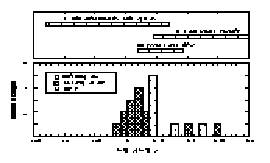
The origin of the Kerguelen Plateau and Islands has long been controversial: are they a continental fragment from the breakup of Gondwanaland or are they entirely oceanic in origin (Watkins et al., 1974)? They are now known to be mostly a result of plume volcanism, that began about 114 Ma ago (Weis et al., 1989). Continental flood basalts (the Rajmahal Traps, and the Bunbury Basalts), the Naturaliste Plateau, and the southern Kerguelen Plateau were the first volcanic products of the Kerguelen Plume, erupted during the breakup of Gondwanaland (Weis et al., 1989; Storey et al., 1989; Mahoney et al., 1983). From 114 Ma to 43 Ma, the northern Kerguelen Plateau-Broken Ridge and the Ninetyeast Ridge formed, and after 43 Ma, Broken Ridge rifted from the Kerguelen Plateau along the southeast Indian Ridge (Royer and Sandwell, 1989). Thus, the Kerguelen Plume passed through several geodynamic environments during its evolution (continental rift, oceanic rift, and the present intraplate setting). The Kerguelen Islands are the most recent (38-0 Ma) Kerguelen plume volcanism. Abundant upper mantle and lower crustal xenoliths from the Islands are included in young alkalic dikes and plugs that cross cut the flat lying basalts comprising the Islands. Given the complex geodynamic environment in which the Kerguelen Plume evolved, the ultramafic xenoliths could contain a geochemical record of the evolution of the plume and the Indian Ocean lithosphere. To this end, we report the Os isotopic results of peridotite xenoliths from two localities (Lac Superieur and Mt. Trapeze), 10 km apart in the Courbet Peninsula, northeastern Kerguelen Islands.
The Os isotopic system is a unique geochemical tracer because it is compatibile in mantle-melt systems and is apparently insensitive to metasomatic processes. We analyzed 11 peridotites from the Mt. Trapeze and 7 from the Lac Superieur localities for their Os isotopic composition (Figure 1). Four peridotites, two from each locality, have a relatively radiogenic Os isotopic composition (187Os/186Os=1.080 ± 002 to 1.150±005), typical of an oceanic island basalt source (Martin, 1991; Hauri and Hart, 1993). The remaining samples show a systematic difference in Os isotopic composition by location. Peridotites from Lac Superieur have 187Os/186Os×1.045, within the range of isotopic compositions of the oceanic upper mantle (Martin, 1991; Hauri and Hart, 1993; Roy-Barman and Allegre, 1994; Snow and Reisberg, 1995). However, harzburgites from Mt. Trapeze are significantly less radiogenic, with 187Os/186Os ranging from 0.989±002 to 1.026±001. The Re-depletion (Walker et al., 1989) ages of these harzburgites are accordingly old: to 1.34 Ga. Similarly unradiogenic Os isotopic compositions have only been observed in the cratonic mantle lithosphere (Walker et al., 1989; Carlson and Irving, 1994; Pearson et al., 1995a; Pearson et al., 1995b), thus strongly suggesting a cratonic origin for these xenoliths. These data suggest that the northern Kerguelen Plateau is not completely oceanic in origin and may have incorporated pieces of the continental mantle lithosphere during the breakup of Gondwanaland.
Carlson, R.W. & Irving, A.J., Earth Planet. Sci. Lett. 126, 457-472 (1994).
Hauri, E.H. & Hart, S.R., Earth Planet. Sci. Lett. 114, 353-371 (1993).
Mahoney, J.J. et al., Nature 303, 385-389 (1983).
Martin, C.E., Geochim. Cosmochim. Acta 55, 14211434 (1991).
Pearson, D.G. et al. Earth Planet Sci Lett 134, 341-357 (1995a).
Pearson, D.G. et al., Geochim Cosmochim Acta 59, 959-977 (1995b).
Roy-Barman, M. & Allegre, C.J., Geochim Cosmochim Acta 58, 5043-5054 (1994).
Royer, J.-Y. & Sandwell, D.T., J. Geophys. Res. 94, 13755-13782 (1989).
Snow, J.E. & Reisberg, L., Earth Planet Sci Lett 133, 411-421 (1995).
Storey, M. et al., Nature 338, 574 - 576 (1989).
Walker, R.J. et al., Geochim. Cosmochim. Acta 53, 1583-1595 (1989).
Watkins, N.D. et al., Geol. Soc. Amer. Bull. 85, 201-212 (1974).
Weis, D. et al., Geochim Cosmochim Acta 53, 2125-2131 (1989). 
Fig. 1: Histogram showing Os isotopic composition of Kerguelen peridotite xenoliths in comparison to ocean island basalts and oceanic and continental lithopheric mantle. Data sources cited in text.